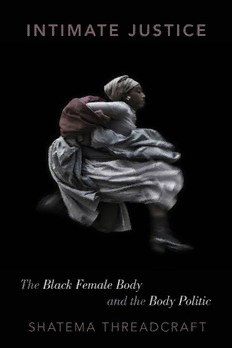Table Of ContentINTIMATE JUSTICE
INTIMATE JUSTICE
The Black Female Body and the Body Politic
Shatema Threadcraft
1
1
Oxford University Press is a department of the University of Oxford. It furthers
the University’s objective of excellence in research, scholarship, and education
by publishing worldwide. Oxford is a registered trade mark of Oxford University
Press in the UK and certain other countries.
Published in the United States of America by Oxford University Press
198 Madison Avenue, New York, NY 10016, United States of America.
© Oxford University Press 2016
All rights reserved. No part of this publication may be reproduced, stored in
a retrieval system, or transmitted, in any form or by any means, without the
prior permission in writing of Oxford University Press, or as expressly permitted
by law, by license, or under terms agreed with the appropriate reproduction
rights organization. Inquiries concerning reproduction outside the scope of the
above should be sent to the Rights Department, Oxford University Press, at the
address above.
You must not circulate this work in any other form
and you must impose this same condition on any acquirer.
Library of Congress Cataloging-in-Publication Data
Names: Threadcraft, Shatema, author.
Title: Intimate justice : the black female body and the body politic /
Shatema Threadcraft.
Description: New York, NY : Oxford University Press, [2016] |
Includes bibliographical references and index.
Identifiers: LCCN 2016006849 (print) | LCCN 2016014054 (ebook) |
ISBN 9780190251635 (hardcover : alk. paper) | ISBN 9780190251659 (Updf)
Subjects: LCSH: African American women—Social conditions. |
African American women—Violence against. | Sex crimes—United States. |
Feminism—United States. | Equality—United States. |
United States—Race relations.
Classification: LCC E185.86 .T448 2016 (print) | LCC E185.86 (ebook) |
DDC 305.48/896073—dc23
LC record available at http://lccn.loc.gov/2016006849
1 3 5 7 9 8 6 4 2
Printed by Sheridan Books, Inc., United States of America
CONTENTS
Preface vii
1. Introduction: Black Female Body Politics 1
2. “What Free Could Possibly Mean”: The Intimate
Sphere in Enslaved Women’s Visions of Freedom 34
3. Racial Violence and the Post- Emancipation
Struggle for Intimate Equality 69
4. Intimate Injustice, Political Obligation, and the
Dark Ghetto 113
5. Intimate Justice 133
Notes 167
Index 197
PREFACE
Elaine Riddick stood before the governor’s task force in 2011 and
asked what the assembled committee thought her life was worth. The
question of what her reproductive life was worth, however, had actu-
ally been answered on March 5, 1968— it was worthless. That day, the
day a fourteen- year- old Riddick delivered her son Tony, a physician
carried out the North Carolina Eugenics Board’s (NCEB’s) order that
she be sterilized.
Riddick’s pregnancy was the result of rape; she had actually been
kidnapped and raped. She grew up in an area of North Carolina nick-
named “Little Korea,” so nicknamed, legend has it, because condi-
tions there— the violence and poverty— mimicked conditions in a
war- torn developing nation. Days before the surgery welfare officials
informed Riddick’s grandmother that she must “consent” to the pro-
cedure or the family would no longer receive state assistance. What
a choice.
Years later, when Riddick learned of what had happened—
after her failure to conceive ended a marriage, after severe depres-
sion and “hibernation” in the face of her friends’ pregnancies—h er
sister suggested that she do something about it. Riddick contacted
the Women’s Rights Project of the American Civil Liberties Union
vii
PREFACE
(ACLU). The organization was searching for plaintiffs in a class- action
suit against the NCEB. Research revealed that the board had ordered
the “operation for sterilization and asexualization” 7,600 times in its
fifty- five- year run.
The North Carolina General Assembly created the NCEB in 1933,
charging the board with reviewing the sterilization of “feebleminded”
and epileptic patients. In the 1930s, an era in which there were few
population- related fears regarding blacks, only 23 percent of those
sterilized were black; by the 1950s, however, due to white anxieties
regarding supporting blacks on welfare, welfare department heads
increasingly saw sterilization as an option for reducing welfare ex-
penditures.1 Between 1964 and 1966 there was a dramatic shift in the
racial makeup of those the board targeted, as the percentage of blacks
sterilized rose to 64 in this period. By the end of its run the board’s
orders for sterilization evinced profound racial bias, as 68 percent of
its victims were black women.
Riddick went on to join the ACLU’s class action and in 1974 the
Women’s Rights Project filed suit against the board in federal court.
Ten years later, after forty- five minutes of deliberation, a jury de-
cided that Riddick had not been “unlawfully deprived of her right to
bear children.”
But she has never given up.
In June 2011, forty- three years after that fateful day, she stood
before the governor’s task force and demanded justice. But what, in
this instance, does justice require?
Riddick’s recent testimony helps to illustrate the fact that the
project of intimate racial justice— the project of providing blacks
their due in the sphere of intimate relations— is incomplete; she and
others demanded justice in our time. And though Riddick and her
fellow NCEB victims were offered small sums by way of restitution,
her story also highlights the apparent inadequacy of redistributive re-
dress alone for what she suffered. Riddick herself makes this clear. Of
the $50,000 compensation the Governor’s Eugenics Compensation
Taskforce offered her so many years later, she says, “Is that what they
viii

